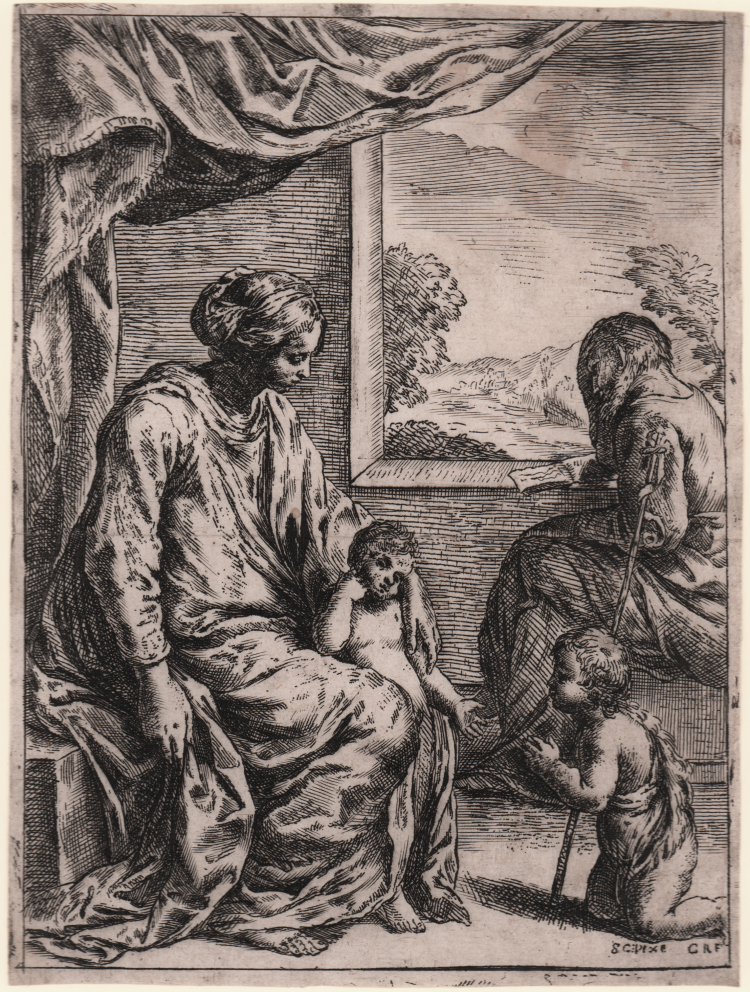




| Reference: | S7252 |
| Author | Carlo RIDOLFI |
| Year: | 1640 ca. |
| Measures: | 185 x 248 mm |



| Reference: | S7252 |
| Author | Carlo RIDOLFI |
| Year: | 1640 ca. |
| Measures: | 185 x 248 mm |
Etching, monogrammed on plate at lower right CRF.
Magnificent proof, with good contrast and very sharp details, on contemporary laid paper, no watermark, trimmed at the platemark, in excellent conditions.
This print derives from a theme by Simone Cantarini, as proven by the inscription at the bottom of the plate bearing the words "SCP exe."
This etching is unknown to Bartsch, while Bellini places it among the works d'apres Cantarini. De Vesme, instead, ascribes it to Ridolfi, interpreting the inscription as "Simone Cantarini pinxit/Carolus Ridolfi Fecit". This attribution is now traditionally accepted, as also confirmed by the British Museum
https://www.britishmuseum.org/collection/object/P_U-3-79
Exceptional example.
Carlo Ridolfi (1594-1658) was an Italian art biographer and painter. He is best known for a biography of the Venetian painters in 1648 titled Le maraviglie dell’ Arte ovvero, Le vite degli Illustri Pittori Veneti and dello Stato. One purpose of his work was to supply a corrective to Vasari, and just as Vasari ascribes all progress in art to Florentines, Ridolfi attempts something similar for the Venetian tradition, with its closer connection to Byzantine art.
|
Bellini pag. 165, De Vesme pag. 17.
|
Carlo RIDOLFI (Lonigo 1594 – Venezia 1658)
|
Carlo Ridolfi (1594-1658) was born in Lonigo under the name of Carlo Sartor; it is not known the circumstances that led him to take the surname of Ridolfi, which likely served to redeem him from humble origins. Much of the information about him comes from the autobiography placed as a seal to Maraviglie dell'arte (1648, 1924, II, pp. 306-323), the literary work for which he is best known. Here he reports that his ancestors, originally from Germany, had moved to the Veneto in the early sixteenth century, engaging in trade: an activity that guaranteed them relative prosperity. Having learned the rudiments of painting from a German artist, and immediately revealing "a natural instinct," in 1607 he was taken to Venice and placed in the workshop of the painter Antonio Vassilacchi, where he served as a garzonato for five years, during which time he acquired the fundamentals of the trade, perhaps assisting him on the most demanding commissions. Despite the fact that his social status prevented him from entering the academic ranks, he himself attests to having attended a number of "reduced virtuosos": above all, the Accademia degli Incogniti, from which he was occasionally engaged as a portraitist and draughtsman of book frontispieces.
The decline of the late Mannerist wave in Venice entailed a serious obstacle to the career of a nostalgic epigone like Ridolfi, whose painting managed not without difficulty to establish itself on the lagoon art scene. After vainly exerting himself with the Venetian authorities to obtain a "gratia" that could guarantee him some benefits for old age, with the good offices of his academic friends, he decided to indulge literary ambitions, applying himself to the genre of illustrious biographies. (See Andrea Polati - Dizionario Biografico degli Italiani - Volume 87 (2016).
|
|
Bellini pag. 165, De Vesme pag. 17.
|
Carlo RIDOLFI (Lonigo 1594 – Venezia 1658)
|
Carlo Ridolfi (1594-1658) was born in Lonigo under the name of Carlo Sartor; it is not known the circumstances that led him to take the surname of Ridolfi, which likely served to redeem him from humble origins. Much of the information about him comes from the autobiography placed as a seal to Maraviglie dell'arte (1648, 1924, II, pp. 306-323), the literary work for which he is best known. Here he reports that his ancestors, originally from Germany, had moved to the Veneto in the early sixteenth century, engaging in trade: an activity that guaranteed them relative prosperity. Having learned the rudiments of painting from a German artist, and immediately revealing "a natural instinct," in 1607 he was taken to Venice and placed in the workshop of the painter Antonio Vassilacchi, where he served as a garzonato for five years, during which time he acquired the fundamentals of the trade, perhaps assisting him on the most demanding commissions. Despite the fact that his social status prevented him from entering the academic ranks, he himself attests to having attended a number of "reduced virtuosos": above all, the Accademia degli Incogniti, from which he was occasionally engaged as a portraitist and draughtsman of book frontispieces.
The decline of the late Mannerist wave in Venice entailed a serious obstacle to the career of a nostalgic epigone like Ridolfi, whose painting managed not without difficulty to establish itself on the lagoon art scene. After vainly exerting himself with the Venetian authorities to obtain a "gratia" that could guarantee him some benefits for old age, with the good offices of his academic friends, he decided to indulge literary ambitions, applying himself to the genre of illustrious biographies. (See Andrea Polati - Dizionario Biografico degli Italiani - Volume 87 (2016).
|